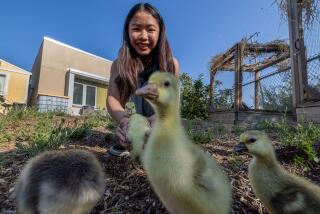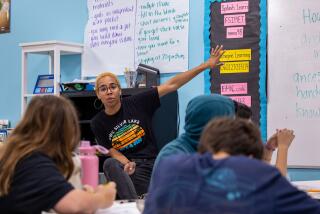Schools Get âRealâ Science Lessons : Education: There are no boring lectures when experts from Sandia laboratories use hands-on approach in New Mexico classrooms.
ALBUQUERQUE â A dozen pairs of eyes are focused on Lynn Ritchie as he blows up a blue balloon and rubs it on his shirt.
He keeps rubbing as he launches into an explanation about electricity, explaining the difference between the static and current kind.
âHow do you use electricity?â the Sandia National Laboratories scientist asks the class--first-, second- and third-graders at Navajo Elementary School.
âTurning on the TV?â asks one youngster.
âThatâs right,â Ritchie replies.
Other kids chime in: âTurning on the fan?â âTurning on the toaster?â âTurning on the computer?â
Yes, Ritchie says, good answers. He moves on to the less obvious: âEver go anywhere in a car?â
âYes,â one boy responds. âI was going to say that.â
Ritchie sticks the balloon on the chalkboard as he explains how little particles called electrons cause the static electricity that keeps it from floating to the floor.
A quality engineer at Sandia, Ritchie is among dozens of chemists, engineers, physicists and other scientists who participate in the Science Advisors Program, a 5-year-old education outreach project run by the U.S. Department of Energy lab.
The programâs two-pronged approach gives students hands-on math and science lessons--everything from arithmetic to weather--and helps teachers improve their math and science education through in-service workshops, according to Sandiaâs Sheri Martinez, a program coordinator.
âWe really want kids to be engaged in science learning,â Martinez says. âWe find people learn best by âdoingâ science. . . . Many teachers hadnât done science that way. Thatâs kind of where we come in.â
The programâs hands-on approach is apparent in Ritchieâs lessons, where besides a balloon he uses such props as a comb, batteries and a flashlight bulb.
âKids do better if you have something for kids to do,â says Ritchie, a 61-year-old father of five and grandfather of 12. âI value the opportunity to share with them my excitement about science. I think sometimes it is not shared in an exciting way.â
The Science Advisors Program--SCIAD for short--doesnât believe in boring lectures. Its basic tenet is that if children are going to develop an affection for science, it has to be through stimulating, interesting, hands-on demonstrations and projects.
Consider, for example, the first-graders who learned how mammals use their senses by pretending to be baby and mother animals, each carrying around a cotton ball with a different scent.
The program offers a resource center at the lab and loans kits, videos and other materials to participating schools. One elementary school teacher doing a lesson on the human body borrowed an apron with detachable body parts, letting students see what organs look like and where theyâre located.
SCIAD participants include about 110 Sandia scientists, two Energy Department employees and some 60 retirees from the lab, the Energy Department, Honeywell Corp. and the military, among other places.
The program is available to kindergartners through high school seniors; it served 194 schools around the state during the last school year, Martinez says.
Ritchie and other participants visit the same schools weekly during the academic year. Each school customizes the program to meet its needs.
But for all the programâs popularity, Martinez says its future is not bright. Funding for the Energy Departmentâs education outreach programs is in jeopardy as Congress looks for ways to cut federal spending.
For now, though, Ritchie continues making his rounds at Navajo Elementary, teaching eight 25-minute classes during a typical day--a schedule he finds anything but grueling.
More to Read
Sign up for Essential California
The most important California stories and recommendations in your inbox every morning.
You may occasionally receive promotional content from the Los Angeles Times.










